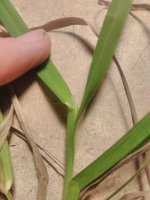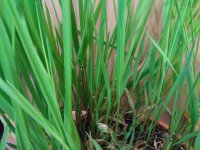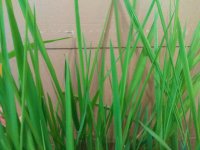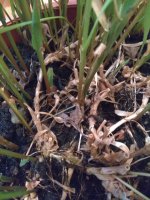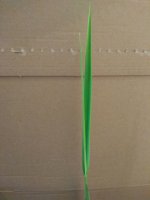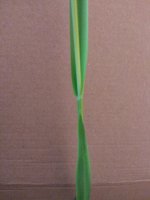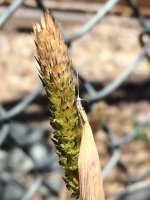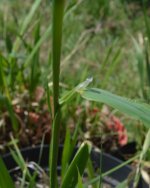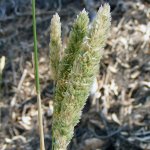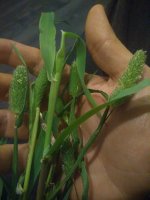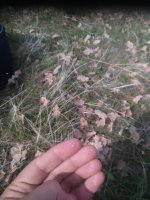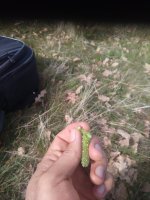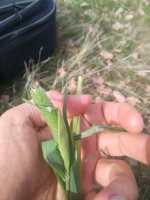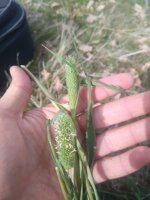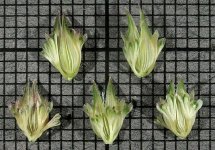-
Members of the previous forum can retrieve their temporary password here, (login and check your PM).
You are using an out of date browser. It may not display this or other websites correctly.
You should upgrade or use an alternative browser.
You should upgrade or use an alternative browser.
Phalaris/other grass types ID thread
- Thread starter zombicyckel
- Start date
Migrated topic.
Hello
im new at this forum.
I have a AQ1,
or I think that it is one, wanted to let you look over it.
who can tell me what that is?
im new at this forum.
I have a AQ1,
or I think that it is one, wanted to let you look over it.
who can tell me what that is?
Attachments
@ Wad
The grass to the right on the picture right above my comment is for sure Phalaris.
It looks pretty thin to be Aquatica.
My best guess would be Phalaris Truncata if you are in the Middle East/Africa/Mediterranean area
If you are in Central/Northern Cali it could be P. Elongata(PERLA grass).
Also the grass to the left could possibly be Phalaris Lemonii depending on where you're at.
I'm sorta doubting the middle and the left are any sort of Phalaris.
After looking at some Lemonii on google I'm not ruling it out.
Your grass on the right is either P. Aquatica, Elongata, or Truncata depending on your geography.
Truncata would have less foliage and look more spikey.
The grass to the right on the picture right above my comment is for sure Phalaris.
It looks pretty thin to be Aquatica.
My best guess would be Phalaris Truncata if you are in the Middle East/Africa/Mediterranean area
If you are in Central/Northern Cali it could be P. Elongata(PERLA grass).
Also the grass to the left could possibly be Phalaris Lemonii depending on where you're at.
I'm sorta doubting the middle and the left are any sort of Phalaris.
After looking at some Lemonii on google I'm not ruling it out.
Your grass on the right is either P. Aquatica, Elongata, or Truncata depending on your geography.
Truncata would have less foliage and look more spikey.
@ Hessaley
Your AQ-1 looks like it probably is AQ-1
Did you grow it from Clones?
The only way to truly pass on the potent genes is through clones.
I've had some good aquatica from seeds nonetheless.
The roots/bases of your grass are definitely Aquatica looking
Your AQ-1 looks like it probably is AQ-1
Did you grow it from Clones?
The only way to truly pass on the potent genes is through clones.
I've had some good aquatica from seeds nonetheless.
The roots/bases of your grass are definitely Aquatica looking
@ misfit
That looks like you could have some P. Arundinacea
The post is from December and that's what the seed head would look like a few months past the
growing season.
Can you post any more pictures?
They should be in full anthesis right now(May-June)
Look up some pix on google or on this forum for reference.
Arundinacea is the only common type to have a flower open up so it could look a lot different
than that seed head right now.
The ligule on the sheeth will help you identify it.
You got about 3 weeks to work with it before the go dormant for the summer
and produce less appealing alkaloids.
That looks like you could have some P. Arundinacea
The post is from December and that's what the seed head would look like a few months past the
growing season.
Can you post any more pictures?
They should be in full anthesis right now(May-June)
Look up some pix on google or on this forum for reference.
Arundinacea is the only common type to have a flower open up so it could look a lot different
than that seed head right now.
The ligule on the sheeth will help you identify it.
You got about 3 weeks to work with it before the go dormant for the summer
and produce less appealing alkaloids.
Chimp Z said:@ Wad
The grass to the right on the picture right above my comment is for sure Phalaris.
It looks pretty thin to be Aquatica.
My best guess would be Phalaris Truncata if you are in the Middle East/Africa/Mediterranean area
If you are in Central/Northern Cali it could be P. Elongata(PERLA grass).
Also the grass to the left could possibly be Phalaris Lemonii depending on where you're at.
I'm sorta doubting the middle and the left are any sort of Phalaris.
After looking at some Lemonii on google I'm not ruling it out.
Your grass on the right is either P. Aquatica, Elongata, or Truncata depending on your geography.
Truncata would have less foliage and look more spikey.
Thank you, I'm in east Europe.
Jagube
Established member
This is what I got as P. aquatica AQ-1.
Can anyone confirm it is P. aquatica at least? Sorry about the quality, I can try and get better photos if these are not good enough.
The side of the flower head that's exposed to the sun (which you can't see in the photo) has a purple coloration.
Can anyone confirm it is P. aquatica at least? Sorry about the quality, I can try and get better photos if these are not good enough.
The side of the flower head that's exposed to the sun (which you can't see in the photo) has a purple coloration.
Attachments
Looks like it could be AQ-1 since the panicle is longer than usual.
It's hard to tell, a lot of suppliers sell regular Aquatica clones as AQ-1
When I grew AQ-1 there was purple on the flower, too.
That is common for Phalaris though.
I've had pretty good brews from purple-tinged grass.
Festi and Samorini paper "Ayahuasca-like Effects Obtained From Italian Plants"
"...From a morphological point of view its
characters are included in the variability limits of the species [cf. Baldini 1993], apart from the
panicle tending to be a little longer at the plant maturity. However, its habitat is quite particular
AQ1 is in fact widespread on the calanchi, that is big furrows dug by the eroding water on clay hill
soils, in general showing a very typical and interesting flora."
Panicle-A panicle is a much-branched inflorescence. ... The branches of a panicle are often racemes. A panicle may have determinate or indeterminate growth.
(the picture below are florets from another AQ-1)
It's hard to tell, a lot of suppliers sell regular Aquatica clones as AQ-1
When I grew AQ-1 there was purple on the flower, too.
That is common for Phalaris though.
I've had pretty good brews from purple-tinged grass.
Festi and Samorini paper "Ayahuasca-like Effects Obtained From Italian Plants"
"...From a morphological point of view its
characters are included in the variability limits of the species [cf. Baldini 1993], apart from the
panicle tending to be a little longer at the plant maturity. However, its habitat is quite particular
AQ1 is in fact widespread on the calanchi, that is big furrows dug by the eroding water on clay hill
soils, in general showing a very typical and interesting flora."
Panicle-A panicle is a much-branched inflorescence. ... The branches of a panicle are often racemes. A panicle may have determinate or indeterminate growth.
(the picture below are florets from another AQ-1)
Attachments
Some more pics of the above species... From the seeds it is evident that it is not brachystachys. The stems are robust close to the base. My current guess is P. paradoxa.
Attachments
I bioassayed 6 blades of the above grass with rue. A minor stomach upset, along with a strong experience though not sure if there was any spirit molecule involved.
Jagube
Established member
IME Phalaris aquatica tea is rather unpalatable and causes an upset stomach too.dithyramb said:I bioassayed 6 blades of the above grass with rue. A minor stomach upset, along with a strong experience though not sure if there was any spirit molecule involved.
I'm curious as to what kind of "strong" (but not decidedly spirit molecule infused) experience you had... or was the strength referring to the rue effects alone?
I need to do a proper diet to understand, jagube. The rue medicine I have this year is amazing. It could be itself alone. Very deep insight and healing, with regular dark visions of rue. A total let go and feeling of very deep trance in the beginning of the experience might be from the grass but I need more experience to confirm.
Alright. I did another trial today with the same medicine minus the grass. The experience did not even come close to yesterday's depth.
So... This grass is active, and probably with mostly non n,n tryptamines. There was a distinctive whole body somatic element in the rue + grass experience, which felt pleasurable and healing. The only discomfort was in my stomach within an hour of ingestion.
P.S. have you guys noticed a distinctive taste of n,n dmt in a brew? I noticed something similar in acacia and chacruna, and a friend who smokes dmt told me he recognized the taste in the acacia brew. This taste was absent in this grass brew.
So... This grass is active, and probably with mostly non n,n tryptamines. There was a distinctive whole body somatic element in the rue + grass experience, which felt pleasurable and healing. The only discomfort was in my stomach within an hour of ingestion.
P.S. have you guys noticed a distinctive taste of n,n dmt in a brew? I noticed something similar in acacia and chacruna, and a friend who smokes dmt told me he recognized the taste in the acacia brew. This taste was absent in this grass brew.
Phalaris grass is its own unique medicine, I feel I've exhausted my word over the years trying to convey this.
How many of you can tell me all the alkaloids and constituents inside any of the plants you ingest?
We know by now that Phalaris grass can be ingested by humans even with the addition of beta carbolines from different plants.
It doesn't all depend on how much DMT is in the grass, we also know that many strains are active without high-DMT amounts. Many shamans administer doses of Psychotria and Caapi that are inactive to the user but very psychedelic for others. You can do chemical tests on these plant collections and find contradicting information. If science is to uncover the secrets of these powerful plants they need to work outside the box.
Phalaris grass deserves respect and that sometimes means holding off on ingesting it before you understand its place in your life.
Everyone is so quick to cut plants down until the plant sits you down and gives you something you don't want.
Cherish the time you're able to share with the plant in its living form.
This can teach you how to build an affinity with these magic treasures.
How many of you can tell me all the alkaloids and constituents inside any of the plants you ingest?
We know by now that Phalaris grass can be ingested by humans even with the addition of beta carbolines from different plants.
It doesn't all depend on how much DMT is in the grass, we also know that many strains are active without high-DMT amounts. Many shamans administer doses of Psychotria and Caapi that are inactive to the user but very psychedelic for others. You can do chemical tests on these plant collections and find contradicting information. If science is to uncover the secrets of these powerful plants they need to work outside the box.
Phalaris grass deserves respect and that sometimes means holding off on ingesting it before you understand its place in your life.
Everyone is so quick to cut plants down until the plant sits you down and gives you something you don't want.
Cherish the time you're able to share with the plant in its living form.
This can teach you how to build an affinity with these magic treasures.
Tony6Strings
Esteemed member
Chimp-Z, what is the name of the grass on your avatar picture?

